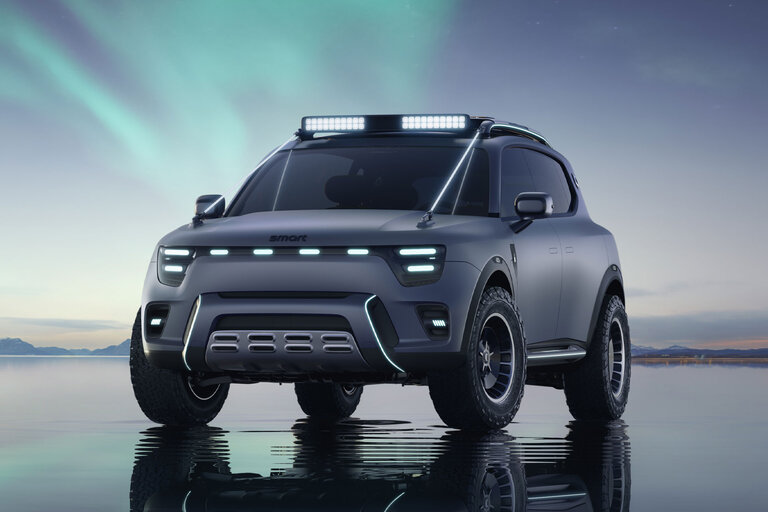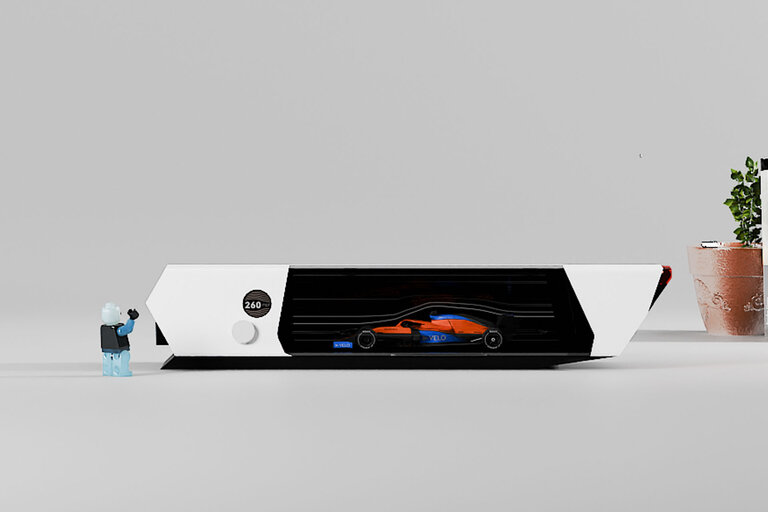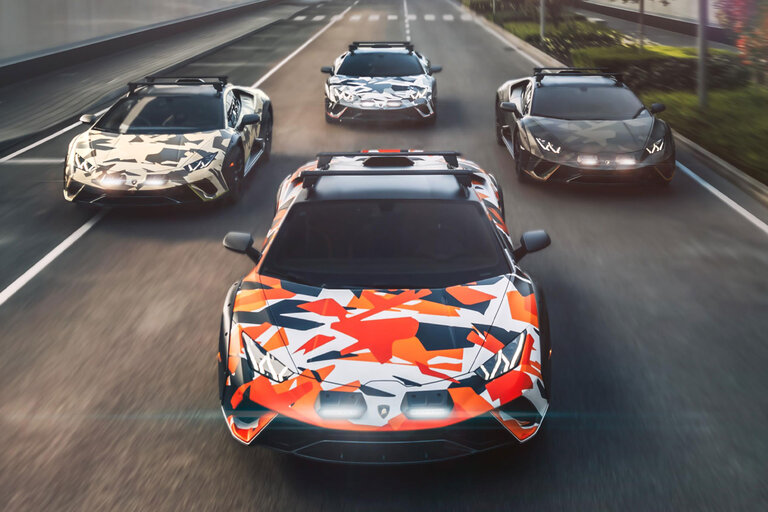
From the March 2008 issue of Car and Driver.
So you’re ready to spend about 35 large on a car, but you’re put off by a BMW 3-series because it reeks of conformity no matter how well it drives. You’re looking for something more special, a car that’s built with speed as the highest priority. It still has to be an everyday driver, but you want wheels that will get you from here to there as fast as possible in any situation. High-class looks aren’t as important as high-class speed.
If that’s your situation, this is your comparison test. Here are three cars that began as humble economy cars and now have about 19 large worth of speed tacked on: the Mitsubishi Lancer Evolution GSR, the Subaru Impreza WRX STI, and the Volkswagen R32. All three have big power, big brakes, big tires, and all-wheel drive, and if you include the short-lived VW Golf Rallye G60, all three have some rally-racing background.
These cars are on their second platform tours through the U.S., although the previous Evolution technically was available as two versions and the STI underwent a string of running changes. The formula is pretty much the same. The Mitsubishi starts as a Lancer but gets an all-new turbocharged 2.0-liter engine making 295 horsepower and 300 pound-feet of torque. It’s also chock full of technology: four-wheel drive with three electronic programs for the center differential, yaw control, and a trick rear axle that splits power from side to side. Our Evolution GSR came with a five-speed manual and no options. Its price was $33,615, exactly $19,000 more than the cheapest Lancer.
The Subaru also goes the turbo-four route, using the same 2.5-liter horizontally opposed engine as in the previous STI. Updates include a larger intercooler and new cylinder heads, and the resultant output comes in at 305 horsepower and 290 pound-feet of torque. The STI has its own little bag of tricks, too: a three-mode engine-control knob and a center differential that splits the torque front to rear, depending on three automatic or six manual settings, controlled by the driver. The only body style is a five-door, and the only transmission is a six-speed manual. Our test car came with a navigation system but, oddly enough, did not come with the gold BBS wheels that must be ordered first. Add $19,300 to a base Impreza wagon, and you get the as-tested price of $37,440.
The only naturally aspirated car in the group was the Volkswagen. Underneath the body-kitted Rabbit skin is, essentially, the powertrain from an Audi TT 3.2 Quattro. The 3.2-liter V-6 puts out 250 horsepower and 236 pound-feet of torque, managed through a six-speed automated, dual-clutch transmission. The list of gizmos starts and ends with stability control, but the R32 is the luxury car of the group with leather, heated seats, and a sunroof—all standard. Including navigation, the R32 is priced at $19,300 more than a base two-door Rabbit, or $35,430.
The formula for this trio is similar, but the resulting cars are as different as the corporations that spawned them. Picking the best one is a lot like playing rochambeau, or “rock paper scissors” if you didn’t go to Montessori school. It really depends on what you need and what you’re up against, and each car has unique advantages. But that sort of circular logic doesn’t result in clear-cut rankings. So after 400 miles of trekking through central Arizona, here’s how they match up.
Third Place: Subaru Impreza WRX STI
The reason for the STI’s third-place finish does not lie with its 5.0-second 0-to-60 time, which is 0.4 second slower than the Evo’s. To reach the mile-a-minute mark in the Subaru requires two gearshifts, which eat up precious 10ths. The STI’s acceleration is further hampered by a lack of low-end torque. The engine almost bogs below 4000 rpm, but at higher revs and full boost, the thrust is dizzying. The quarter-mile sprint between the STI and Evo is close enough that picking a winner in a rematch is basically a coin flip.
HIGHS: Fantastic high-end grunt, supple ride, an interior worthy of the sticker price.
LOWS: Vague, overly assisted steering; flaccid power below 4000 rpm; a chassis set to terminal understeer.
The super Subie does not lack for power, even if some of the performance numbers look deceptively slow. Where it falls down is in the steering department, which is too light and far too vague. Most annoyingly, the only feel conveyed through the steering wheel is in the form of kickback from road bumps.
That’s a shame because the STI has a lot going for it. Despite editor-in-chief Csere’s opinion that the STI wins the ugliest-car-on-the-planet contest, our test crew was smitten with the flared wheel arches, vents, and scoops, especially in side and rear profile. The interior also drew praise for its comfortable driving position and trim materials that inspire pride instead of apologies.
Around town and cruising on the highway, we find that Subaru delivers on the promise of a more refined and civil STI, but when the road turns all spaghetti-like, the STI comes up short. The aforementioned steering is the main culprit—it makes it difficult to figure out what’s going on at the wheels—even though the body motions are well controlled and the overall ride is the best in the group. The brakes, despite the best 70-to-0-mph stopping distance of 153 feet, lack feel as well. Both factors chip away at the driver’s confidence. Those still brave enough to push the STI will quickly discover understeer through almost any type of corner, and the many settings of the center differential don’t seem to offer a cure.
THE VERDICT: Plenty of power in need of some finesse.
The STI is supremely capable, but we wish it were more inspiring away from the drag strip. It’s technically impressive, but the lack of driver involvement makes this Subaru a blunt tool.
2008 Subaru Impreza WRX STI
305-hp turbo flat-4, 6-speed manual, 3366 lb
Base/as-tested price: $35,640/$37,440
C/D TEST RESULTS
60 mph: 5.0 sec
100 mph: 12.6 sec
1/4 mile: 13.5 @ 103 mph
Braking, 70–0 mph: 153 ft
Roadholding, 300-ft-dia skidpad: 0.89 g
C/D observed fuel economy: 17 mpg
Second Place: Volkswagen R32
Informed observers see the R32 as an overpriced GTI or a bargain Audi TT, occupying an unmarketable limbo between the two. Spend some time with the R32, though, and it emerges as the best of both worlds: all the hatchback functionality of the GTI combined with the sweet engine and all-weather handling of the TT.
HIGHS: Spine-tingling exhaust note, smooth power delivery, an interior you could live in.
LOWS: Stiff ride, only marginally better performance than the GTI’s.
One tester described the R32 exhaust growl as Porsche-like, a comment that was met with universal approval. We even found ourselves tapping the steering-wheel-mounted paddle shifters up and down the gears just to hear the V-6 play a symphony throughout its rev range. And it’s not simply smooth-sounding: The R32 provides a gratifying, linear throttle response that even the most subtle of turbo fours cannot achieve.
Refinement is also the key inside the R32, which was acclaimed for its luxury appointments. Compared with the no-frills Evo, the R32 is loaded with features that we’ve come to expect from cars priced above 30 grand. The interior is nearly identical to the Rabbit and GTI’s, only with the added ’zazz of machined aluminum trim and “R” logos on the pedals. The gauges, highlighted by glowing blue needles, are the best in the group.
On the highway, the R32 is serene, wind and road noise are muted, and the seats are comfortable and supportive. And although the VW is down two doors on the Evo and STI, the back seat earned top marks for accepting two passengers with grace.
With 45 fewer horses than the second-most-powerful car here and a relatively meager 236 pound-feet of torque, it’s no surprise that the R32 is the slowest of the trio. We didn’t expect much from the handling, either, given the heavily siped all-season tires, but we were pleasantly surprised. Corner turn-in is sharp, and the even feel of the steering makes for easy midcorner corrections when they’re needed.
The suspension works well through corners and smooth roads but is flinty over bumps and rough pavement. Still, the R32 is a blast to drive. It’s only when the speeds climb and you start to push the boundaries of the R32’s limits that you come upon an edge that’s kind of ragged. In lesser circumstances, the R32 is as polished as a telescope mirror in almost every way.
THE VERDICT: Requires a certain amount of intelligence to properly appreciate.
Even its looks are the most sedate of the group. There are no wings or scoops; the R32 just goes about its business with a quiet confidence. It’s the car for the boy racer who has finally grown up. And speaking of grownups, two of our three-guy test crew admitted the R32 is the car they’d buy of this group. That could be due to the wisdom of increasing age, or maybe they’re getting soft. Either way, we like the R32.
2008 Volkswagen R32
250-hp V-6, 6-speed automated manual, 3552 lb
Base/as-tested price: $33,630/$35,430
C/D TEST RESULTS
60 mph: 5.4 sec
100 mph: 14.9 sec
1/4 mile: 14.2 @ 98 mph
Braking, 70–0 mph: 175 ft
Roadholding, 300-ft-dia skidpad: 0.89 g
C/D observed fuel economy: 19 mpg
First Place: Mitsubishi Lancer Evolution GSR
On paper, the Lancer Evolution looks like a slight underdog to the Impreza WRX STI because it has less horsepower and an almost-200-pound weight disadvantage. Normally, this is the part where we explain how the slower car is better to drive and thus becomes the ultimate winner. This time, though, the statistically obsessed can take comfort in the fact that the first-place car is quickest in a straight line, pulls the highest g on the skidpad, and costs less that its rivals. As a bonus, the Evo is the best car to drive of the three, which is what really matters. We constantly argue this point to the chagrin of some letter writers.
HIGHS: Yaw control that abolishes understeer, awesome grip, great low-end torque for a turbo.
LOWS: Needs a telescoping steering wheel, one more gear, an an interior worthy of the price.
The Evo averages an astonishing 4.6 seconds from 0 to 60 mph. It might only beat the Subaru STI to that mark because the Evo can get there, just barely, in second gear, although it also holds a slight advantage through the quarter-mile, too. That’s despite ceding 10 horsepower and 192 pounds of curb weight to the STI.
The torque peak of the Evo occurs at a higher rpm than the STI’s, but the seat of our pants tells us the Evo has more torque at lower rpm. From a standstill, the STI can launch at the engine’s rev limiter, which tortures the clutch but gets it off the line explosively. The Evo, however, is limited to a more mechanically sympathetic 5000 rpm until the wheels are moving, and that low-end torque is what helps it overcome the initial launch advantage of the STI.
The Evolution’s engine starts pumping out usable propulsion at about 3000 rpm, and turbo lag is less noticeable with its smoother power delivery. It doesn’t have the exciting whoosh that’s present as the STI builds steam, but it’s much easier to live with. The engine is the Evo, although it’s not all rainbows and buttercups. The noise from under the hood sounds more like a blender than an internal-combustion engine, and smoothness on our preproduction test car was set closer to chop than liquefy.
The five-speed gearbox only contributes to the din—at 80 mph in fifth gear, the engine is buzzing at 3850 rpm. One test driver complained of a headache after 20 minutes of high-speed flogging. He’s a bit of a whiner, but engine and road noise are ever present in the Evo. Uncomfortable noise seems to bounce off the ceiling and hit your ears a second time.
Aside from the Recaro seats—they have deep side and thigh bolsters, plus shoulder bolsters—the Evo interior is only a step or two above rental-car banality. White stitching on the leather steering wheel and padded cloth on the door panels and center armrest break up the expanses of black plastic and save the Evo from total underachievement in this price bracket.
But let’s not dwell on the bad, because there is plenty of good about the Lancer Evolution. For starters, it clings to the road. We recorded 0.97 g on a slippery skidpad, fighting oversteer all the while. That’s right, oversteer. Most cars lose grip at the front end during a steady-state corner, but the electronic wizardry in the Evolution’s systems makes sure the back end is the first thing to gently break loose.
Since the skidpad only measures maximum lateral grip, it’s not a consistent indication of good handling, but in this case it’s perfectly in line with the over-the-road experience. The quick steering—2.3 turns lock-to-lock—offers more feel than that of the other cars. The stiff brake pedal is more communicative, too, and the brakes don’t ever seem to fade.
THE VERDICT: Simple and effective at its single purpose of easy speed.
The Evolution inspires confidence in the way it goes over the road without event or drama or any strenuous amount of work from the driver. It’s predictable, it’s capable, and it’s more communicative than the competition. That lets you drive it harder and faster, so if you want to get somewhere in a hurry, the Lancer Evolution GSR is the best choice.
2008 Mitsubishi Lancer Evolution GSR
295-hp turbo inline-4, 5-speed manual, 3558 lb
Base/as-tested price: $33,615/$33,615
C/D TEST RESULTS
60 mph: 4.6 sec
100 mph: 12.5 sec
1/4 mile: 13.4 @ 103 mph
Braking, 70–0 mph: 161 ft
Roadholding, 300-ft-dia skidpad: 0.97 g
C/D observed fuel economy: 19 mpg
This content is created and maintained by a third party, and imported onto this page to help users provide their email addresses. You may be able to find more information about this and similar content at piano.io
Source link





